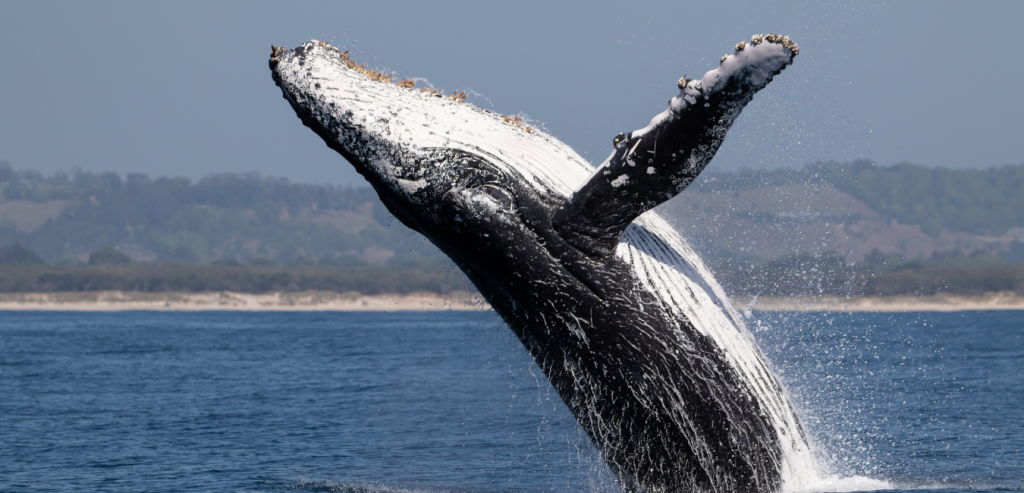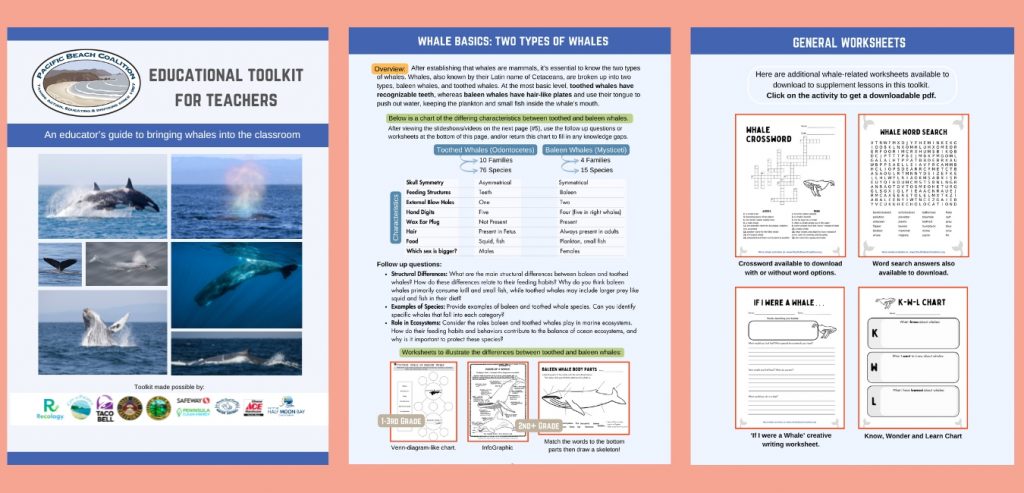Whales, Earth Honoree 2024

PBC’s Earth Honoree of 2024: Whales
What is a Whale?
Whales, dolphins and porpoises are the commonly used terms to describe animals of the order Cetacea. Cetacea is the scientific classification. Cetaceans are mammals, which means they are endothermic (produce body heat from within), give birth to well-developed young, have fur at some point in their life cycle (dolphins are born with a few bristly hairs on their chin), and females nurse their young. People are mammals, as are giraffes, elephants, raccoons and rabbits. Cetaceans are entirely aquatic, finding food, mating, giving birth and raising their young all in the water.
Cetaceans are extremely well-adapted to aquatic life. They have a streamlined body with an elongated rostrum for easy swimming, flukes (tail fin) to propel them through the water; a dorsal fin to stabilize them in the water, nostrils which have migrated to the top of their head to become the blowhole, and pectoral fins to aid in steering. In addition to these morphological adaptations, they are physiologically adapted to dive to great depths for long periods of time. There is a great diversity among the 76 species of cetaceans, but the basic external anatomy is shown below.
Fun Facts About Whales
- A group of whales is called a pod.
- A whale’s ear wax can tell its age and also with what toxins it has come into contact.
- By using their tails in an up-and-down motion rather than side to side, whales can reach speeds of up to 30 miles an hour.
- Each fluke is unique and special to that whale. Similar to a person’s fingerprint, whale lobes have distinctive traits that are helpful in identifying specific whale species.
- The blowhole is attached to the whale’s trachea, and connected to the lungs. Unlike humans the whale’s trachea and esophagus are separate, therefore a whale can never choke on food!
- Were you aware that the average human sneeze travels at approximately 100 mph? In contrast, a whale can release a single breath reaching speeds of 300 mph, which is three times faster than the average human sneeze! It can reach up 30 feet in the air!
Did You Know?
Do whales sing?
Whales are known to carry a tune. While it is not positive why they sing, it is believed that their melodies are used for a number of reasons. Some whales may be looking to attract a mate or to watch over their calves (babies). Other whales might use a song to locate their prey or simply to communicate. The tune of a whale can be heard for miles and miles and can last as long as 30 minutes.
How are whale populations determined?
Via sight by boats and airplanes, underwater acoustic recordings, mark and recapture methods, visually identifying individuals based on marks and scarring. Hard to know about and make estimates on whales that live out in the open ocean.
How do whales sleep?
In order to keep from drowning, whales do not fully sleep like other mammals do.
Whales sleep by shutting down only half of their brain for rest. This lets the other half of their brain remain alert to make sure they take breaths when needed. Some whales, such as sperm whales, are known to snooze vertically, keeping their noses out of the water.
Why is whale poop important?
Phytoplankton, microscopic marine algae, act as the ocean’s powerhouse and form the foundation of the food web. An intriguing link exists between these tiny plants and whale poop, which provides essential nutrients. When whales release their waste at the ocean’s surface, phytoplankton thrive and produce over half of the Earth’s oxygen. Considering that oceans cover 71% of the planet, take a moment to appreciate whales for their crucial role in this process while enjoying fresh air and measuring whale lengths. More than 50% of the air you breathe is thanks to the ocean, phytoplankton, and the remarkable impact of whale poop.
Learn More About the Whales
The Pacific Beach Coalition’s 2024-5 Earth Hero is whales! We encourage you to join us and “Shake Your Tail – Save a Whale.” We’ve compiled a virtual toolkit packed full of worksheets, lesson plans, video links and more for educators to bring whales into and out of the classroom. Learn more!
For students K-8 with some high school level material.
Students will investigate how blubber help whales, how whale poop and climate change relate, why do whales migrate thousands of miles each year, and more!
This toolkit was organized and created by Chloe Van Loon with help from Sheila Gamble-Dorn and Fran Quartini. Thanks to Caren Loebel-Fried and Ashley Juricich, for their artwork. Big thanks to our Earth Month and year long sponsors, who made this toolkit possible.

